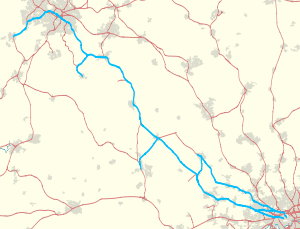Chiltern Railways
Chiltern Railways[1] is a British train operating company owned by Arriva UK Trains that has operated the Chiltern Railways franchise since July 1996. It operates commuter/regional rail passenger services from its central London terminus at London Marylebone along the M40 corridor to destinations in Buckinghamshire, Oxfordshire and Warwickshire, as well as long-distance services to the West Midlands along two routes. Services on the Chiltern Main Line run from London to Birmingham Snow Hill, Stratford-upon-Avon and Oxford, with some peak-hour services extended to Kidderminster.
A Class 168 Clubman and a Class 68 locomotive at London Marylebone in 2015 | |||
| Overview | |||
|---|---|---|---|
| Franchise(s) | Chiltern 21 July 1996 – 2 March 2002 3 March 2002 – 11 December 2021 | ||
| Main route(s) | Chiltern Main Line | ||
| Other route(s) |
| ||
| Fleet size |
| ||
| Stations called at | 62 | ||
| Stations operated | 32 | ||
| Parent company | Arriva UK Trains | ||
| Reporting mark | CH | ||
| Technical | |||
| Length | 336.4 | ||
| Other | |||
| Website | chilternrailways | ||
| |||
Chiltern Railways also runs trains on the London to Aylesbury Line to Aylesbury (some of which continue on to Aylesbury Vale Parkway), and on the Princes Risborough to Aylesbury and Oxford to Bicester branch lines.
History
In June 1996 M40 Trains[2] was awarded the Chiltern Railways franchise by the Director of Passenger Rail Franchising for a period of seven years, with operations commencing on 21 July 1996.[3] M40 Trains was a management buyout led by some former British Rail managers who held a combined 51% shareholding, backed by John Laing (26%) and 3i (23%). In a restructure in March 1999, John Laing took an 84% shareholding, with the remaining 16% owned by the former British Rail managers.[4][5]
In March 2000 the Shadow Strategic Rail Authority announced that M40 Trains and Go-Ahead had been shortlisted to bid for the next Chiltern franchise.[6][7] In August 2000 M40 Trains was awarded a new franchise, to run for 20 years conditional on various investments being made.[8][9][10] The new franchise started on 3 March 2002.
In August 2002 John Laing acquired the remaining 16% of shares in M40 Trains it did not already own.[11] In September 2006 John Laing was purchased by Henderson Equity Partners.[12]
In December 2004 Chiltern Railways took over operation of passenger services on the Leamington Spa to Stratford-upon-Avon branch line from First Great Western Link.
In June 2006 M40 Trains was invited by the Department for Transport to lodge a bid to operate the Snow Hill Lines then operated by Central Trains, as part of the letting of the West Midlands franchise. The bid was not successful.[13][14]
In July 2007 Henderson Equity Partners put Laing Rail up for sale.[15] Arriva and Go-Ahead both expressed an interest in acquiring Laing Rail,[16][17] but by December 2007 only Deutsche Bahn of Germany and NedRail of the Netherlands remained in the bidding contest.[18][19] In January 2008 Laing Rail was purchased by Deutsche Bahn, and Chiltern became part of the DB Regio group.[20][21]
A restructure in early 2011 saw DB Regio become a subsidiary of Arriva UK Trains.[22]
In May 2011 Chiltern took over operating services on the Oxford to Bicester Line from First Great Western.[23][24]
Gerrards Cross incident
Tesco proposed building a supermarket over the railway line near Gerrards Cross railway station in 1996,[25] which, following an initial objection by the local council was approved by the Deputy Prime Minister John Prescott in July 1998. Due to a lack of space in the area, Tesco had proposed building over the railway line, which would free up a large area of land suitable for the development.[25]
During construction, the partially built tunnel collapsed on 30 June 2005. Nobody was injured but the line was closed for over six weeks, eventually reopening on 20 August 2005. Compensation by Tesco to Chiltern Railways and Network Rail was estimated to be between £200m and the retailer pledged to fund a media campaign to win back passengers lost by the closure of its route. Construction of the tunnel finally resumed in January 2009.[26] The store opened in late November 2010.[27]
Services
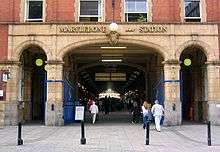
Chiltern Railways operates regular services on five routes.
The Chiltern Main Line is the core route for the majority of Chiltern Railways services and is one of two "mainline routes" operated by the company. The route links the major cities of London and Birmingham (Marylebone and Snow Hill stations respectively), passing through the towns of High Wycombe, Banbury, Royal Leamington Spa, Warwick and Solihull. Chiltern Railways operates trains along the entire line, services ranging from stopping suburban trains (e.g. London Marylebone – Gerrards Cross) to express trains running the full length of the line between London and Birmingham. The fastest timetabled journey from Birmingham to London by this route is 99 minutes (compared with 82 minutes using Avanti West Coast services between Birmingham New Street and London Euston via the West Coast Main Line).[28] In addition to the Chiltern Railways services, CrossCountry also operates regular services on the line north of Banbury, and West Midlands Trains operates regular services north of Dorridge.
The London to Aylesbury Line is the second "mainline route" operated by the company. The route links London (Marylebone) with Aylesbury via Amersham. All Chiltern Railways services on this route run the full length of the line between Marylebone and Aylesbury stations and call at all stations north of Amersham; most trains are extended one station further to Aylesbury Vale Parkway. The line runs alongside London Underground's Metropolitan line between Finchley Road (just north of Marylebone station) and Harrow-on-the-Hill, each operator running on separate tracks. Beyond Harrow-on-the-Hill, the tracks are shared between Chiltern Railways and Metropolitan line services. This is the only example of National Rail services using non-Network Rail tracks, and it uses a unique unregulated track-access agreement with London Underground.[29] Beyond Amersham (where the Metropolitan line terminates), all services are operated by Chiltern Railways only.
The other three routes regularly served by the company are all branch lines. The Princes Risborough to Aylesbury Line links Princes Risborough, on the Chiltern Main Line, with Aylesbury, on the London to Aylesbury Line. Most trains on the line continue beyond Princes Risborough to London Marylebone, which gives Aylesbury an alternative route to reach central London; however, a few services terminate at Princes Risborough. The Oxford to Bicester Line branches off the Chiltern Main Line just south of Bicester and links the town with Oxford. The line is mostly served by express services to and from Marylebone. Until December 2016, the line terminated a few miles northeast of Oxford, at the nearby Oxford Parkway station; the line was then extended to the main Oxford station.[30] The Leamington to Stratford Line branches off the Chiltern Main Line at Hatton (a few miles west of Leamington Spa) and runs to Stratford-upon-Avon. The branch line is also operated by regular West Midlands Trains services.
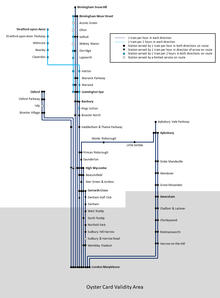
As of May 2019, its routes off-peak Monday to Friday include:[28][31]
Intercity
| Mainline | |||
|---|---|---|---|
| Route | tph | Calling at | Stock |
| London Marylebone to Birmingham Moor Street | 1 | High Wycombe, Banbury, Leamington Spa, Warwick Parkway, Solihull | 68, 168, 172 |
| London Marylebone to Birmingham Snow Hill | 1 | Bicester North, Banbury, Leamington Spa, Warwick, Warwick Parkway, Dorridge, Solihull, Birmingham Moor Street | |
Regional
| London - Oxford | |||
|---|---|---|---|
| Route | tph | Calling at | Stock |
| London Marylebone to Oxford | 1 | High Wycombe (Oxford-bound only), Bicester Village, Oxford Parkway | 168, 172 |
| 1 | High Wycombe (London-bound only), Haddenham & Thame Parkway, Bicester Village, Islip (limited), Oxford Parkway | ||
| London - Banbury | |||
| Route | tph | Calling at | Stock |
| London Marylebone to Banbury | 1⁄2 | Denham Golf Club (Banbury-bound only), Gerrards Cross, Beaconsfield, High Wycombe, Princes Risborough, Haddenham & Thame Parkway, Bicester North | 165, 168, 172 |
| London - Stratford | |||
| Route | tph | Calling at | Stock |
| London Marylebone to Stratford-upon-Avon | 1⁄2 | Denham Golf Club (Stratford-bound only), Gerrards Cross, Beaconsfield, High Wycombe, Princes Risborough, Haddenham & Thame Parkway, Bicester North, Kings Sutton, Banbury, Leamington Spa, Warwick, Hatton, Claverdon (limited), Bearley (limited), Wilmcote, Stratford-upon-Avon Parkway | 165, 168, 172 |
Commuter
| Leamington - Birmingham | |||
|---|---|---|---|
| Leamington Spa to Birmingham Moor Street | 1⁄2 | Warwick, Hatton, Lapworth, Dorridge, Solihull | 165, 168, 172 |
| London - Aylesbury via High Wycombe | |||
| Route | tph | Calling at | Stock |
| London Marylebone to Aylesbury | 1 | Gerrards Cross, Seer Green and Jordans, Beaconsfield, High Wycombe, Saunderton, Princes Risborough, Monks Risborough, Little Kimble[lower-alpha 1] | 165, 168, 172 |
| London Marylebone to Gerrards Cross | 1 | Wembley Stadium, Sudbury & Harrow Road (limited service), Sudbury Hill Harrow, Northolt Park, West Ruislip, Denham, Denham Golf Club (London-bound only) | |
| London Marylebone to High Wycombe | 1 | Wembley Stadium, South Ruislip, Gerrards Cross, Beaconsfield | |
| London - Aylesbury via Amersham | |||
| Route | tph | Calling at | Stock |
| London Marylebone to Aylesbury | 1 | Harrow-on-the-Hill, Rickmansworth, Chorleywood, Chalfont & Latimer, Amersham, Great Missenden, Wendover, Stoke Mandeville | 165, 168 |
| London Marylebone to Aylesbury Vale Parkway | 1 | Harrow-on-the-Hill, Rickmansworth, Chorleywood, Chalfont & Latimer, Amersham, Great Missenden, Wendover, Stoke Mandeville, Aylesbury | |
- Little Kimble is mostly served hourly, but there are two-hour gaps between some services.
Extension to Kidderminster
At peak times on weekdays, some services between London Marylebone and Birmingham are extended beyond the latter, to and from Kidderminster (via Stourbridge Junction). These trains run to Marylebone in the morning peak and return towards Kidderminster in the evening peak.[28] The trains also call at some stations between Birmingham Moor Street and Kidderminster, although not all services have the same calling pattern.
As of July 2016, there are four trains per day in each direction between Marylebone and Kidderminster, plus another one which is extended only as far as Stourbridge Junction. On Saturdays, there are also four morning trains from Kidderminster to Marylebone from the December 2017 return services in the evening were introduced. There were no Chiltern Railways service to Kidderminster on Sundays until the December 2017 timetable when 2 trains in each direction were introduced.[28]
Regular trains between Birmingham Moor Street, Stourbridge Junction and Kidderminster are operated by West Midlands Trains as part of its Snow Hill route service.
Parliamentary trains
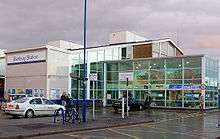
Chiltern Railways operates two parliamentary train services:[28]
- Cherwell Valley line: there is a single daily parliamentary service operating on the Cherwell Valley Line from Oxford to Banbury, operated by Chiltern Railways. This service runs on Tuesdays to Saturdays just after midnight and calls at Tackley, Heyford and Kings Sutton - the three intermediate stations on the line. There is no corresponding return service heading towards Oxford. This service exists to maintain route knowledge for Chiltern Railways' drivers. Regular services on the line are operated by Great Western Railway and CrossCountry.
- New North Main line/Greenford branch line: the company also operates a weekday parliamentary service to and from West Ealing in the late morning. As of April 2019, there is one train per day from South Ruislip, running via the single-track line parallel to London Underground's Central line formerly known as the New North Main Line, then joining the Greenford branch line just beyond Greenford itself, before terminating at West Ealing. The corresponding return service runs through to High Wycombe back the same way. Neither service calls at any intermediate stations.[32][33] Until December 2018, these services ran to and from London Paddington.[34][35][36][37] They were then diverted to West Ealing following closure of the easternmost section of the New North Main line for High Speed 2 construction.
Buckinghamshire Railway Centre
On certain Bank Holiday Mondays, services are extended from Aylesbury to the Buckinghamshire Railway Heritage Centre facilities at Quainton Road, a short way north of Aylesbury Vale Parkway. However, this did not happen in 2019 and their future is uncertain. The link will continue to be used by freight services to Calvert.
Tickets
Since winning the franchise, Chiltern has introduced "Route: High Wycombe" tickets for the Chiltern route between Birmingham and London that are considerably cheaper than "Route: Any Permitted" tickets, valid on the faster Avanti West Coast service to London Euston as well a number of other operators and routes. Chiltern offers only Standard Class, not Standard and First Class as on Avanti services. However, Chiltern does offer a premium economy "Business Zone" carriage on a small number of peak-time trains between Birmingham or Oxford and London. Passengers pay an upgrade fee to sit in a larger first-class-style seat;[38] and formerly, this upgrade came with complimentary refreshments but, since May 2017, refreshment services have been cut on all Chiltern Railways services, meaning the "Business Zone" no longer comes with complimentary refreshments.[39]
Performance
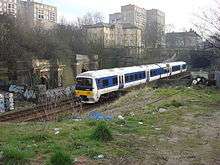
Chiltern was considered one of the best operators in Britain, with Public Performance Measure (PPM) regularly over 90%,[40] until the introduction of changes[41] in November 2015 and infrastructure issues saw punctuality fall to 86% in December 2015.[42] Chiltern's PPM is measured on stricter conditions than its long-distance rivals, such as Avanti West Coast, as Chiltern has a 5-minute window for performance while others have a 10-minute window.
Performance figures published by Network Rail rate Chiltern Railways sixth in train operating companies in the UK at 89.4% (PPM – period 9) and 94.3% (MAA) for the year to 12 December 2015.[43]
A new timetable introduced in September 2011, combined with significant disruption caused by engineering work, caused a negative reaction from customers. A petition to have the service reviewed was started, and articles describing the disrupted journeys of commuters appeared in the local press.[44]
A new timetable introduced in December 2012 also met with frustration and opposition from some customers, particularly those using Saunderton and Princes Risborough stations.[45]
Project Evergreen
Evergreen is the name given by Chiltern to the major infrastructure works that the company has committed to over the 20-year duration of its franchise to improve routes and services. This has been divided into three distinct phases.
Evergreen 1
The main focus of phase 1 was the redoubling of the Chiltern Main Line between Princes Risborough and Bicester North in 1998 and Bicester North and Aynho Junction in 2001, together with the reconstruction of Haddenham and Thame Parkway from a single platform to two platforms, the installation of a new platform at Princes Risborough, and the raising of the line speed limit.[48]
Evergreen 2
Phase 2 began after the award of Chiltern's new 20-year franchise. This entailed a realignment of the route through Beaconsfield to allow speeds to be increased to 75 mph, improved signalling between High Wycombe and Bicester and between Princes Risborough and Aylesbury, the construction of two new platforms at London Marylebone on the old carriage sidings, and the construction of a new depot at Wembley.[48]
Evergreen 3
The Department for Transport, Chiltern Railways and Network Rail agreed in January 2010 to a £250m upgrade of the Chiltern Main Line.[49][50]
Phase 1
Phase 1 of the project, now complete, involved upgrading the Marylebone – Birmingham Chiltern Main Line to permit 100 mph (160 km/h) running on an additional 50 miles (80 km) of route. Junctions at Neasden, Northolt and Aynho were remodelled to permit higher speeds.[51] The 'up' through track has been restored at Princes Risborough, the existing 'up' line becoming a platform loop, a new turnback siding has been provided at Gerrards Cross, and a new, straighter 'down' through track built from Northolt Junction (where the original layout favoured the now little-used Paddington route) to Ruislip Gardens. The existing 'down' track continues to serve South Ruislip station. The former speed restrictions through Bicester North have been removed to permit 100 mph running.[51] Two additional terminating platforms at Birmingham Moor Street were reopened in December 2010. Accelerated services were initially planned to start in May 2011, but there were delays and it was not until 5 September 2011 that Chiltern was able to introduce a new timetable to take advantage of the improvements.[52][53]
As a result of the speed increases, journey times have been reduced significantly. From Marylebone, the fastest peak-hour journey time to Birmingham Moor Street is now 90 minutes, instead of 117 minutes previously. The table below outlines the peak timetable improvements.[49]
| Previous | Post Phase 1 | |
|---|---|---|
| Gerrards Cross | 21 | 18 |
| High Wycombe | 34 | 23 |
| Princes Risborough | 41 | 32 |
| Bicester | 56 | 44 |
| Banbury | 63 | 50 |
| Leamington Spa | 85 | 67 |
| Solihull | 107 | 84 |
| Birmingham (Moor Street) | 117 | 92 |
Chiltern Railways former chairman Adrian Shooter said, "This is the biggest passenger rail project for several generations not to call on the taxpayer for support. Working closely with Network Rail, we are going to create a new main-line railway for the people of Oxfordshire and the Midlands. This deal demonstrates that real improvements to rail services can be paid for without public subsidy by attracting people out of their cars and on to trains."
Phase 2
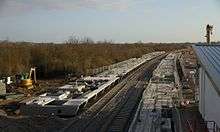
In October 2012 the Secretary of State for Transport granted permission for work to begin on Phase 2 of the Evergreen 3 project, with services between London Marylebone and Oxford.[54][55] Under Phase 2, a quarter-of-a-mile double track has been constructed joining the Oxford to Bicester Line at Bicester Village to the Chiltern Main Line, allowing a new Oxford to London Marylebone service to operate. A new station, Oxford Parkway, has been constructed at Water Eaton; the service between Oxford Parkway and London started on 26 October 2015, with the link from Oxford Parkway to Oxford becoming operational on 12 December 2016.[30] All signalling on the route (including the new platforms at Oxford) is controlled by Marylebone Signalling Centre.
As part of Phase 2, the Oxford to Bicester Village service transferred from First Great Western to Chiltern in May 2011.[23] Part of the line between Wolvercote Tunnel (on the outskirts of Oxford) and Bicester Village was restored to double track, and the scheme included additional platforms at Oxford, Islip and Bicester Village.
Network Rail provided the capital for the upgrade and will recover this through a facility charge over the subsequent 30 years, initially payable by Chiltern until its franchise expires, and then by the next franchisee. The infrastructure upgrade was carried out by main contractor BAM Nuttall, in partnership with Jarvis and WS Atkins.[49][56][57]
Oxfordshire County Council supported the scheme, but had to be convinced of the benefits of the new Oxford Parkway station at Water Eaton, which is in the Green Belt.[58] There was a further setback to the plan when in November 2011 a planning inspector withheld approval because it was found that bats were roosting in Wolvercote Tunnel. Great crested newts also have a breeding habitat close to the route.[59] The "bat problem" however seems to have been resolved.[60]
Rolling stock
Chiltern Railways inherited a fleet of 34 Class 165 Turbos from British Rail. In December 2004 a further five Class 165s were transferred from First Great Western Link.[61] All 39 were overhauled by Bombardier at Ilford EMU Depot in 2003 – 2005, including installation of air-conditioning and removal of the hopper opening windows and the first-class seating.[62][63][64] As they were designed for suburban rather than InterCity use, they tend to be concentrated on services to Aylesbury and Banbury, although this stock can also be found operating the service between Birmingham and Leamington Spa.
Chiltern ordered several batches of Class 168 Clubmans, entering service between 1998 and 2004, and now has nine three-car and ten four-car sets. These operate across the network.
In April 2003 Chiltern restored a Class 121 Bubble Car for use on the Aylesbury to Princes Risborough shuttles, a second following in May 2011 after overhaul at Tyseley TMD.[65][66][67] In March 2013, a third Class 121 (121032) was acquired from Arriva Trains Wales for use as a spare parts donor. On 19 May 2017 the Chiltern Bubble cars ran for the last time, as their age made spare parts very difficult to obtain.[68]
In January 2008 Chiltern ordered four two-coach Class 172 Turbostars. These entered service in June 2011.[69] Because they cannot be fitted with tripcock safety equipment necessary to operate on London Underground lines, they cannot operate via Amersham unless attached to a Class 165 or 168. Although initially intended for use on all-stations services out of London, they frequently operate to Birmingham.
From December 2010 Chiltern began operating two peak-hour loco-hauled services consisting of a Class 67 hauling Mark 3 coaches and a Driving Van Trailer. One set was hired from fellow DB Regio subsidiary Wrexham & Shropshire to operate a Birmingham Moor Street to London Marylebone service while the other was made up of some DB-Regio-owned Mark 3s painted in British Rail blue/grey and Virgin Trains livery and operated from Banbury to London Marylebone.[70]
After Wrexham & Shropshire ceased operations in January 2011, Chiltern began using a second ex-Wrexham & Shropshire set from May 2011. For the introduction of Chiltern's new timetable in September 2011 they had a Mainline logo and blue stripes added to their silver livery.[71] Motive power was provided by Class 67s, 67010, 67012-015 and 67018, all modified to operate with Driving Van Trailers.
In 2012 the ex-Wrexham & Shropshire Mark 3s were overhauled, and fitted with sliding plug doors (similar to those fitted to South West Trains' Class 444 Desiros) and toilet retention tanks by Wabtec's Doncaster Works. Once this was complete, a further ten Mark 3s were overhauled by Wabtec to create a fifth set and bring the existing sets up to six coaches.[72] In 2012 the DB-Regio-owned Mark 3s used on the peak-hour Banbury service were given a light overhaul at LNWR, Bristol, and the Virgin-liveried examples repainted into British Rail blue/grey. To allow Class 168s to be cascaded to the new Oxford services as part of Evergreen 3, more Mark 3s are to be returned to service in the future.[73]
Between 2015 and 2016, Class 170 Turbostars with First TransPennine Express transferred to Chiltern Railways.[74] Chiltern took five of the First TransPennine Class 170s from May 2015 and the remaining four in July 2016. Upon delivery, the Class 170s were modified to allow them to be used with Chiltern's existing Class 168s, and reclassified as Class 168/3s.[75]
In early 2014, Chiltern Railways agreed a sub-lease from Direct Rail Services (DRS) for six Class 68 locomotives for use on its London Marylebone to Birmingham service to replace the existing fleet of Class 67s. Maintenance and commissioning for the new fleet is assisted by DRS.[76]
In 2017, Chiltern Railways entered into an agreement with Artemis Intelligent Power and the Rail Safety and Standards Board to provide one of its redundant DVTs as a donor vehicle for conversion into a new type of diesel locomotive.[77]
Current fleet
| Trainset | Class | Image | Type | Top speed | Carriages | Number | Routes operated | Built | |
|---|---|---|---|---|---|---|---|---|---|
| mph | km/h | ||||||||
| Networker | Class 165/0 | DMU | 75 | 120 | 2 | 28 | All Chiltern Railways services (apart for Mainline services) | 1990–92 | |
| 3 | 11 | ||||||||
| |||||||||
| Bombardier Turbostar | Class 168/0 Clubman |  |
100 | 160 | 4 | 5 | Chiltern Mainline and some local services | 1998 | |
| Class 168/1 Clubman | .jpg) |
3 | 6 | Chiltern Mainline and some local services | 2000 | ||||
| 4 | 2 | Chiltern Mainline and some local services | 2000 | ||||||
| Class 168/2 Clubman |  |
3 | 3 | Chiltern Mainline and some local services | 2004 | ||||
| 4 | 3 | Chiltern Mainline and some local services | 2004 | ||||||
| Class 168/3 Clubman | 2 | 9 | Chiltern Mainline and some local services | 2000 | |||||
| Class 172/1[78] | 2 | 4 | All Chiltern Railways services (apart for London-Aylesbury line) | 2011 | |||||
| Stadler UKLight | Class 68[79] | .jpg) |
Diesel locomotive | 100 | 160 | 6 | 8 | Chiltern Main Line services | 2014 |
| Mark 3[80][81] | .jpg) |
Passenger Carriage | 125 | 200 | 31 | 1975–88 | |||
| Driving Van Trailer | 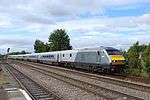 |
Control car | 6 | 1988 | |||||
Past fleet
Former train types operated by Chiltern Railways include:
| Trainset | Class | Image | Type | Top speed | Carriages | Number | Routes operated | Built | Withdrawn | |
|---|---|---|---|---|---|---|---|---|---|---|
| mph | km/h | |||||||||
| Bubble Car | Class 121 |  |
DMU | 70 | 112 | 1 | 2 | Princes Risborough to Aylesbury Line | 1959–60 | 19 May 2017[82] |
| Class 67 | .jpg) |
Diesel locomotive | 125 | 200 | N/A | 5 | Chiltern Main Line services | 1999-2000 | December 2014 | |
Plans
Active
In addition to the completed Evergreen initiatives, other potential enhancements for Chiltern's route have been discussed, but had not progressed as at the end of 2017. These include:
- Upgrading the Acton–Northolt line (formerly the "New North Main Line") to new platforms at Old Oak Common. This upgrade will also extend to London Paddington to increase capacity on the Chiltern Main Line as there is no room to expand the station at Marylebone.[83][84][85][86][87]
- Restoration of fast through lines at Beaconsfield as part of a longer-term aspiration for a 90-minute journey time between London and Birmingham.[88]
- Remodelling Banbury Station and tracks.[89]
- Building of the West Hampstead interchange to allow easy interchange with the London Overground - North London Line, Jubilee line, Metropolitan line and Thameslink services.[90]
- New Chiltern Metro Service that would operate 4+tph for Wembley Stadium, Sudbury & Harrow Road, Sudbury Hill Harrow, Northolt Park, South Ruislip and West Ruislip. This would require a reversing facility at West Ruislip, passing loops at Sudbury Hill Harrow, and a passing loop at Wembley Stadium (part of the old down fast line is in use as a central reversing siding, for stock movements and additionally for 8-car football shuttles to convey passengers to the stadium for events).[91] This 'Chiltern Metro' service was not programmed into the last round of franchising agreements.
- Re-opening the passenger line between Oxford and Bedford as part of the East West Rail project, and from Aylesbury to East West Rail at Claydon LNE Junction to provide a route to Milton Keynes and the West Coast Main Line via Bletchley .[92] Two miles of the line north of Aylesbury re-opened on 14 December 2008 terminating at a new station, Aylesbury Vale Parkway.[93] However, in late 2017 the Government announced that the private company, East West Rail Ltd., had been formed to build and operate the line exclusively.[94][95]
- Opening a rail line from Aylesbury to an M6-M1 Parkway Station near Rugby.[96]
- Extending Oyster Pay-as-you-go to High Wycombe and Aylesbury.[97]
Since successful completion of Project Evergreen 3 has fulfilled Chiltern Railways' obligation to invest in infrastructure, there is no clear road to completion for these projects.[98]
See also
- Chiltern Main Line
- London to Aylesbury Line
- Varsity Line
- Deutsche Bahn, Chiltern Railways' owner
- London Midland
References
- Companies House extract company no 3007939 The Chiltern Railway Company Limited
- Companies House extract company no 3005018 M40 Trains Limited
- "M40 to put new stock on Chiltern" The Independent 26 June 1996
- "Fat cat row in Chiltern bid". Accountancy Age 1 March 1999
- "Full steam ahead" Accountancy Age 14 April 1999
- Six Companies Shortlisted for First Franchise Replacement Round Shadow Strategic Rail Authority 14 March 2000
- Go-Ahead shortlisted for Chiltern and South Central rail franchises Go-Ahead Group 14 March 2000
- Laing Rail to Build upon Chiltern Success John Laing 10 August 2000
- "Chiltern Railways to Ride Again" Coventry & Warwickshire News 10 August 2000.
- "Chiltern wins first 20-year franchise" The Guardian 19 February 2002
- "Review (proof 2)" (PDF). Retrieved 23 November 2012.
- "Laing accepts £887m takeover bid" BBC News 19 September 2006
- "Bidders announced for rail franchises" New Civil Engineer 19 September 2006
- Department for Transport Announces Winner of West Coast Franchise Department for Transport 21 June 2007
- "Chiltern Railways is on the market". Railnews. Stevenage. 31 July 2007. Archived from the original on 8 November 2007. Retrieved 10 September 2007.
- Milmo, Dan (7 September 2007). "Arriva poised to bid for Chiltern". The Guardian. London. Retrieved 8 September 2007.
- "Go-Ahead interested in Chiltern Railways bid – CEO". Reuters. 7 September 2007. Retrieved 8 September 2007.
- O'Connell, Dominic (9 December 2007). "Rail rivals line up Chiltern". The Sunday Times. London.
- "Deutsche Bahn and NedRail line up Chiltern". business-sale.com. 11 December 2007.
- "Deutsche Bahn announces acquisition of Laing Rail" (Press release). Chiltern Railways. 21 January 2008. Archived from the original on 13 May 2008. Retrieved 22 January 2008.
- "Deutsche Bahn buys Laing Rail" Construction News 21 January 2008
- "Review of the year to 31 December 2010: Strongly positioned for future growth" (Press release). Arriva. 3 May 2011.
- "Oxford to Bicester Town Service Change of Train Operator". First Great Western. Retrieved 28 April 2011.
- Chiltern Railways takes over Bicester to Oxford services News Archived 23 July 2012 at the Wayback Machine Chiltern Railways 28 April 2011
- Glancey, Jonathan (25 August 2005). "In a hole". The Guardian. Retrieved 17 June 2009.
- Hansford, Mark (15 January 2009). "Tesco restarts work at tunnel collapse site". New Civil Engineer. London. Retrieved 6 May 2009.
- Abell, Jack (3 December 2010). "Tesco finally opens its doors". Buckinghamshire Advertiser. Uxbridge. Archived from the original on 17 August 2011. Retrieved 13 December 2010.
- "May - December 2019 timetables". Chiltern Railways.
- Yonge, John (November 2008) [1994]. Jacobs, Gerald (ed.). Railway Track Diagrams 5: Southern & TfL (3rd ed.). Bradford on Avon: Trackmaps. maps 41C, 42A, 42B, 43A. ISBN 978-0-9549866-4-3.CS1 maint: ref=harv (link)
- "Chiltern Oxford Launch" (Press release). Chiltern Railways. Archived from the original on 16 May 2016. Retrieved 20 January 2016.
- "Route Map". Chiltern Railways. Retrieved 15 June 2020.
- 2V27 1102 South Ruislip to West Ealing Real Train Times 10 December 2018
- 2M27 1147 West Ealing to High Wycombe Real Train Times 10 December 2018
- 2V27 1057 South Ruislip to London Paddington Real Train Times 7 December 2018
- 2M29 1135 London Paddington to High Wycombe Real Train Times 7 December 2018
- "Riding the Parliamentary Train out of Paddington". IanVisits. Retrieved 8 December 2017.
- "Chiltern Railways Timetable" (PDF).
- "Faq categories - Chiltern Railways". www.chilternrailways.co.uk.
- "Chiltern Railways axes all on-board catering".
- "Proportion of trains running on time".
- "Chiltern Railways admits problems". 16 November 2015.
- "Performance". Archived from the original on 8 December 2015. Retrieved 26 December 2012.
- "Rail performance results period 9". Network Rail. Archived from the original on 8 December 2015. Retrieved 26 December 2012.
- Dunhill, Lawrence (24 September 2011). "Beaconsfield commuters say new Chiltern line is 'misery'". Bucks Free Press. High Wycombe. Retrieved 5 October 2011.
- Cain, Rebecca (4 January 2011). "Commuters call for a return to a better train service". Bucks Free Press. Princes Risborough. Retrieved 27 January 2013.
- "Display Report | Office of Rail Regulation - National Rail Trends Portal". Dataportal.orr.gov.uk. Archived from the original on 8 November 2016. Retrieved 15 October 2018.
- Road, Office of Rail and. "Display Report - Office of Rail Regulation - National Rail Trends Portal". dataportal.orr.gov.uk.
- Chiltern Renaissance – The Evergreen Success Rail.co 26 October 2011
- "£250 investment from Chiltern Railways creates new main line" (PDF) (Press release). Chiltern Railways. 15 January 2010. Archived from the original (PDF) on 2 March 2012.
- "£250m Rail Investment to Bring Much Faster Journeys for Chiltern Passengers" (Press release). Network Rail. 15 January 2010. Archived from the original on 5 May 2013.
- "Evergreen 3 progress". Modern Railways. London. December 2010. p. 9.
- "Chiltern Railways plan to make Bicester well connected". Railnews. Stevenage. 29 August 2008. Retrieved 7 September 2008.
- "Project Evergreen 3". Chiltern Railways. 2009. Archived from the original on 28 August 2009. Retrieved 6 February 2009.
- "Chiltern Railways given green light to build new rail line between Oxford and London" (Press release). Chiltern Railways. 18 October 2012. Archived from the original on 24 January 2013. Retrieved 18 November 2012.
- McGregor, Sam (19 October 2012). "New £130m rail link to London approved". Oxford Mail.
- "Chiltern Railways announces £250m improvements and new main line to be built by BAM Nuttall". New Civil Engineer (London). 15 January 2010.
- "BAM Nuttall lands £190 million Evergreen 3 Contract for Chiltern Railways" (Press release). Camberley: BAM Nuttall. January 2010. Archived from the original on 31 August 2011. Retrieved 20 October 2012.
- "Rail link plan runs into problems". Oxford Mail. 15 September 2009. Retrieved 10 October 2009.
- Little, Reg (17 November 2011). "Rail line hits buffers amid bat risk fear". The Oxford Times. p. 1.
- "Chiltern Railways: Oxford–London line statement". 8 March 2012. Archived from the original on 19 April 2012. Retrieved 18 April 2012.
- "Thames 165s on their way to Chiltern" Rail issue 487 12 May 2004 page 27
- Our Train Fleet Archived 17 July 2012 at the Wayback Machine Chiltern Railways
- "Chiltern axes First Class seating" Rail issue 452 8 January 2003 page 57
- "It's one class only on Chiltern" Entrain issue 14 February 2003 page 10
- "Unique revamped Class 121 enters service for Chiltern" Rail issue 460 30 April 2003 page 60
- "BR green 'bubble car' headlines £1million upgrade by Chiltern" Archived 16 October 2013 at the Wayback Machine Rail Express 27 May 2011
- 55034 Class 121 Driving Motor Brake Second (Returned to Mainline use) The Railcar Association
- "First Generation DMU era ends as Chiltern Bubblecars head for retirement" The Railway Magazine issue 1395 June 2017 page 8
- "Angel Trains orders 'Green Trains' for the UK Rail Market" (Press release). Angel Trains. 31 January 2008.
- "Chiltern commence Birmingham loco-hauled" Archived 16 October 2013 at the Wayback Machine. Rail Express. 14 December 2010.
- "Chiltern mounts Silver Trains Challenge to Virgin". Railnews. 5 September 2011.
- "Chiltern Railways puts refurbished Mk 111 coaches into service" Railway Gazette International 31 May 2012
- Comfort, Nick; Pritchard, Robert (2010). "Marylebone-Birmingham expresses from December". Today's Railways. Sheffield (99): 7.
- "Campaigners' fury as nine TransPennine Express trains sent south in 'crazy and scandalous' move". Manchester Evening News. 3 March 2014.
- Wilson, James (9 January 2015). "Train users in Mid Cheshire suffer capacity setback". Knutsford Guardian. Retrieved 28 February 2015.
- "Chiltern leases six Class 68 locos for Mainline services in £15m deal". Rail Technology Magazine. 15 April 2014. Retrieved 12 August 2014.
- "RSSB funds powertrain demonstrator". London: Rail Safety and Standards Board. 10 March 2017. Archived from the original on 22 August 2018. Retrieved 21 August 2018.
- "Angel Trains orders 'green trains' for the UK rail market" (Press release). Angel Trains. 31 January 2008.
- "Angel Trains orders 'green trains' for the UK rail market". rail technology magazine. 15 April 2014.
- "Passenger Board Annual Report 08/09" (PDF). Chiltern Railways. 24 June 2009. Archived from the original (PDF) on 29 December 2009.
- "Coaching Stock Design Contract for Chiltern Railways". Railway Technology. 21 July 2009.
- "Retirement of the Class 121 "Bubble Car" |" (Press release). Chiltern Railways. Retrieved 12 July 2017.
- Chilterns Route Study to tackle capacity challenges, Rail Magazine, 5 July 2016
- Development of Train Services for Chiltern Routes (Draft Publication February 2011) (PDF)
- Longer trains, new track, upgraded stations - planning for future demand for rail travel in the West Midlands and Chilterns Network Rail media centre, 4 July 2016
- West Midlands and Chilterns Route Study Summary Archived 24 September 2017 at the Wayback Machine (PDF) Network Rail
- West Midlands & Chilterns Route Study Advice and choices for funders (PDF) (Report). Network Rail. August 2017. p. 80. Retrieved 2 March 2018.
- "Route plans 2008: Route 16: Chilterns" (PDF). Network Rail. April 2008. p. 12. Archived from the original (PDF) on 20 March 2009. Retrieved 31 July 2008.
- "Route plans 2007: Route 17: West Midlands" (PDF). Network Rail. 2007. p. 35.
- "Planning Framework for West Hampstead Interchange Area Appendix 2". London Borough of Camden. 19 April 2005. p. 25. Archived from the original on 11 June 2011. Retrieved 26 February 2017.
- "There's more to Chiltern than the Chilterns – The Case for a Chiltern Metro". London Travel Watch. January 2001. Archived from the original on 11 March 2007.
- Buggins, Arryn (10 August 2000). "Bid To Reopen Central Railway To Passengers". CWN. Coventry. Retrieved 15 April 2008.
- "Services at Aylesbury's new train station to begin on Sunday". The Bucks Herald. Aylesbury. 9 December 2008.
- "Chancellor accepts East West Rail targets and strengthens plans with extra cash". www.railtechnologymagazine.com.
- Transport Secretary officially launches East West Railway Company at Bletchley Park East West Rail, 22 November 2017
- Buggins, Arryn (11 August 2000). "The Next Train Calling at Rugby... Could be Chiltern". CWN. Coventry. Retrieved 15 April 2008.
- "Exciting times ahead for passengers using Chiltern Railways!" (Press release). Chiltern Railways. 22 January 2007. Archived from the original on 8 May 2009. Retrieved 2 January 2009.
- "Private Sector Specification and Delivery of Enhancement" (PDF). International Council on Systems Engineering. 22 June 2010.
Further reading
External links
| Wikimedia Commons has media related to Chiltern Railways. |
| Preceded by Network SouthEast As part of British Rail |
Operator of Chiltern franchise 1996 – 2021 |
Incumbent |
